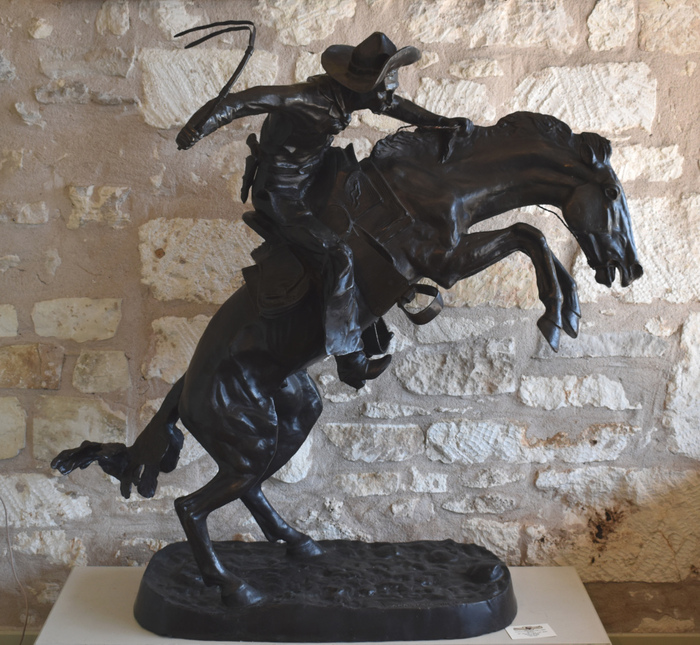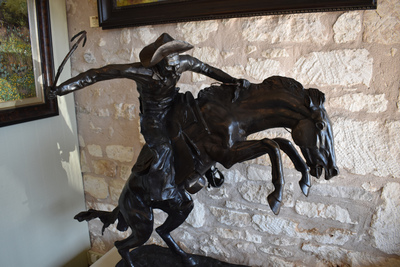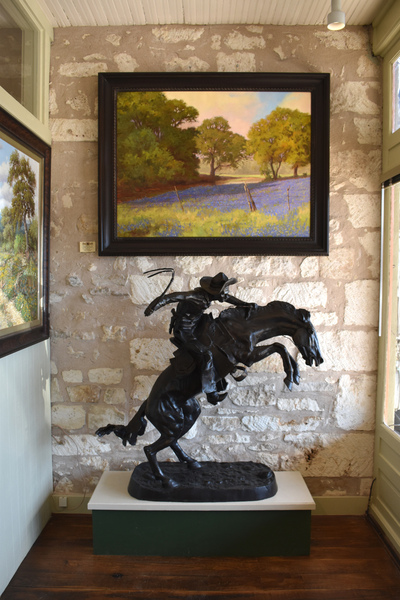Frederic Remington "Bucking Bronco"
-
- Frederic Remington
- (1861-1909)
- New York / Kansas / Connecticut
- Image Size: 56" across 52" tall 25" deep
- Medium: Bronze Sculpture
- Recast
- "Bucking Bronco"
- Contact for Price & Info
- View All By This Artist
Details
Very large example of this subject.
-
Biography
Frederic Remington (1861-1909)
In his lifetime polymath Frederic Remington was the most successful and famous Western American artist. His immense talents included excelling as an illustrator, author, sculptor, and fine artist. His was a life tragically cut short. Born on October 4, 1861 in Canton, a small berg in bucolic upper state New York, he was much influenced by his father Seth Pierpont Remington, a Republican journalist who founded the St. Lawrence Plaindealer. His father had been a captain in the Civil War, and in 1870 President Ulysses S. Grant appointed him United States Collector of the Port of Ogdensburg, New York. In 1876 young Frederic enrolled at Highland Military Academy in Worcester, Massachusetts where he studied for the next two years. Two years later he enrolled at Yale for one year to study in the School of Fine Arts. His two loves were art and football. Only three months into school, he published his first illustration in the on-campus newspaper Yale Courant. On the gridiron he was a natural, demonstrating great strength and agility. Like Theodore Roosevelt, Remington also enjoyed boxing.
A year later he met his future wife Eva Caten from Gloversville, New York. After the death of Remington’s father from tuberculosis on February 18, 1879, Eva rejected his first marriage proposal. Floundering, Remington headed to the American West to find himself—much like Theodore Roosevelt did when his mother and wife died on the same day. That led to a trip to Montana where he completed a number of sketches. Invigorated by his Western experiences, in February 1883 he headed to Kansas and with part of his inheritance bought a 160 acre sheep ranch near Peabody, Kansas. That failed adventure lasted about a year, and he then relocated to Kansas City, Missouri where Eva would join him as his wife. Yet he squandered the rest of his inheritance on a saloon there.
After more illustrations were sold to Harper’s Weekly, in 1885 the Remingtons moved to New York City, and in 1886 he attended the Art Students League. By then Remington was earning $1,200 a year, twice the income of a school teacher. Other magazines such as St. Nicholas and Outing also published his art. His work certainly impressed a young Theodore Roosevelt who was chronicling his life in Medora—now in North Dakota—for a serial that ran in The Century Magazine. It was very common at the time for authors to serialize their works in magazines before they were published in book form. In the fall of 1887 Remington was commissioned to illustrate the magazine stories which ended up in Roosevelt’s 1888 classic book Ranch Life and the Hunting Trail. Early on, a lasting friendship between the two was cemented through these publications. By 1889 he had garnered national notoriety as one of the most accomplished illustrators in the country. He was a national celebrity.
In 1889 his monumental canvas A Dash for the Timber was exhibited at the National Academy of Design. The New York Times reported, “The picture at the Autumn exhibition of the Academy of Design before which stands the largest number of people is Frederic Remington’s Dash for the Timber.” A Silver medal for Last Lull in the Fight followed at the Exposition Universelle in Paris. In 1891 the National Academy of Design elected Remington as an Associate member. Yet he was never admitted as National Academician, despite support from fellow artists Gilbert Gaul, Childe Hassam, and others.
His financial success allowed the Remingtons to move into a grand home he named Ednion—Algonquin for “a place where I live”—in New Rochelle, New York. A young Norman Rockwell would someday paint in his studio. Through his travels, Remington embraced social Darwinism—survival of the fittest—that championed the U.S. military’s domination of the inferior Native Americans. Theodore Roosevelt, George Armstrong Custer, and Remington—along with most other Americans—idolized Charles Darwin.
As early as 1888 Remington started contributing short stories along with illustrations to magazines. His writings teemed with romantic Western stories chalk full of drama and violence. Initially, they presented the cavalryman as the hero and the Indian as the villain, especially when the Indian had been tainted with the vices of the white man. His West was the “frontier model” where the fittest were rugged individuals from northern Europe and white Americans.
Even though he was an accomplished author and painter, perhaps his greatest talent was as a sculptor. His bronzes are more famous and collectible than any other Western American artist. And yet his bronze repertoire was completed in just fourteen years. Starting in order of modeling, they are: The Broncho Buster, The Wounded Bunkie, The Wicked Pony, The Scalp, The Norther, The Cheyenne, The Buffalo Signal, Coming Through the Rye, The Mountain Man, The Sergeant, Paleolithic Man, Savage, Polo, The Rattlesnake, Dragoons 1850, The Outlaw, The Horse Thief, The Buffalo Horse, The Cowboy, Trooper of the Plains 1868, The Broncho Buster (large), and The Stampede.
His Coming Through the Rye was widely viewed by the public at two world’s fairs. A New Jersey artisan in 1904 was commissioned by Remington to produce a heroic size plaster of the sculpture for the 1904 Louisiana Purchase Exposition in St. Louis, Missouri (called Off the Trail). It was then shipped to Portland, Oregon the next year for the Lewis and Clark Exposition and titled Shooting Up the Town. The Cowboy—his only monumental bronze—was commissioned in 1905 by the Fairmount Park Art Association in Philadelphia. The twelve feet high bronze was shipped to Philadelphia in May 1908 and unveiled in the park as The Mounted Cowboy.
In 1900 Remington turned to Riccardo Bertelli at Roman Bronze Works in Brooklyn to cast his bronzes by the lost-wax casting process which allowed higher detail in the finished product. The Norther that year was his first bronze by this method. The Cheyenne was copyrighted the next year. His last, The Stampede, was modeled in late 1909 just before Remington died but wasn’t copyrighted until 1910. His friend and accomplished sculptor Sally Farnham was called upon by Eva to oversee the production after her husband’s death. The Broncho Buster reins as Remington’s most popular model.
Many consider his last few years as his greatest period. Peter Hassrick divided Remington’s art into five periods: illustration; academic Realism; nocturnal paintings; Impressionism; and finally Symbolism. Remington’s paintings provided the financial means to build Lorul Place, his last home and studio, on forty-six acres in Ridgefield, Connecticut. Construction was completed in the spring of 1909. By the time of his death, he had produced over 3,000 illustrations for periodicals. The Frederic Remington Art Museum in Ogdensburg, New York, as it has been known since 1981, houses material from Eva’s estate that includes paintings, sketches, two bronzes and his library. The building was home to Eva and her sister after Remington died in 1909, and after she died it became known as the Remington Art Memorial in 1923.
Peter H. Hassrick adroitly noted, “Unlike Russell, Remington never saw himself as ordinary, either as an artist or a man. His aspirations were to be at the absolute top of his field, and his ego matched his formidable girth; he identified with epic men serving epic causes.”Born at Canton, New York, Frederic Remington became the foremost turn-of -the-century illustrator, painter, and sculptor of western action-packed subjects with cowboys, Indians, horses, soldiers, and other frontier characters. His style was realistic, and much of his work was narrative with strong implication that the West belonged to the white man, but his Indians were portrayed with dignity and nobility.
During his lifetime, Remington created about 25 bronzes with the most famous being "The Bronco Buster", and one of the largest being the cowboy statue for Fairmount Park in Philadelphia. He also did about 3000 paintings, some which he burned towards the end of his life.
Remington was the son of the local newspaper publisher, and in 1878 entered the Yale School of Fine Arts for one year, excelling at football and art. Because of his father's death, he could not afford to return to school, so he traveled West and made numerous sketches, selling one to "Harper's Weekly." He studied for a short time with J. Alden Weir, a founder of American Impressionism, at the Art Students League in New York, but did not stay there for long because he had little patience for formal schooling.
In the next years, he made many trips to the West and Plains States and worked as a cowboy, ranch hand, lumberjack, and gold miner in Apache country in Arizona. He also sent illustrations back to "Outing Magazine," "Harper's Weekly," and "Scribners." Publishers used everything he sent them because his experiences were so fascinating to easterners. He also illustrated articles by Theodore Roosevelt for "Century Magazine" and for Frances Parkman's novel, "Oregon Trail." During the Spanish American War, he was an artist-correspondent in Cuba. Other travels were to North Africa, Mexico, Russia, Germany and England.
Regarding himself always as a fine artist, he regularly sent paintings to New York City from the West for exhibition at the National Academy of Design and the American Watercolor Society. He also exhibited in New York galleries including the Knoedler Gallery, where he had his last public show in 1926.
He was ever-fascinated by the motion of horses and took many photos of them in the newly invented roll film box camera. He painted and sculpted the animals often, frequently at full gallop, but always juxtaposed them with human figures, never drawing single horse portraits. The same was true of his landscapes, which invariably had human activity in them. In 1895, he began working in bronze and cast his famous work, "The Bronco Buster." He became so enamored of sculpting that his painting quality deteriorated.
His early paintings of the West were much more literal depictions than his romanticized later ones of the disappearing West. In his later years, he preferred to paint nocturnes because it allowed him greater freedom and depth of perspective.
For his bronze sculpture, he used the foundry Roman Bronze Works, the first foundry in the United States to devote itself exclusively to the age-old lost wax method. Foundry owner Ricardo Berteli and Remington worked closely together to explore technical and creative aspects of casting bronze.
Because Remington is so associated with the American West, it may be surprising that he spent time with Augustus Saint-Gaudens and others in the artist colony in Cornish, New Hampshire. He almost bought property there, finding the fellowship of the community very stimulating.
He died in 1909 at Ridgefield, Connecticut from an appendicitis, when he was age forty eight. From 1886 to six months before his death, his home had been in New Rochelle, New York where he had a large studio.
Sources:
Harold and Peggy Samuels, Encyclopedia of the American West
Matthew Baigell, Dictionary of American Art
Peter Falk, Who Was Who in American Art
Alma Gilbert, Director of the Cornish Colony Museum, New Hampshire



